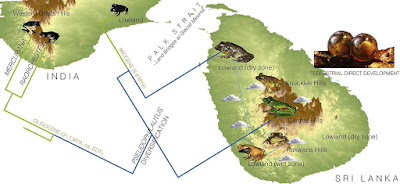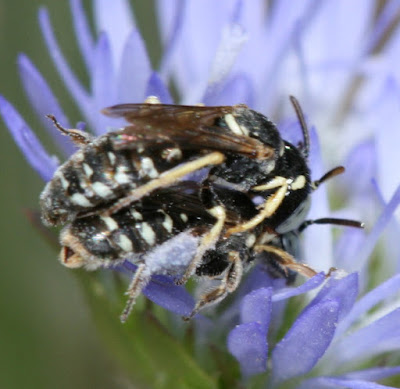[Most Recent Entries] [Calendar View]
Friday, November 23rd, 2018
| Time | Event | ||||||
| 2:51a | [Herpetology • 2019] Diversification of Shrub Frogs (Rhacophoridae, Pseudophilautus) in Sri Lanka – Timing and Geographic Context
Highlights • Pseudophilautus diversification, begins during Oligocene (31 MYA) • A stately pace of lineage accumulation despite orogeny and climate change. • Assemblages in most regions comprise of species arising from diverse clades. • MRCA of a back-migrating clade to India (8.8 MYA), reconstructs as a lowland form. • Island’s mountains serve as species pumps and refuges for Pseudophilautus evolution. Abstract Pseudophilautus comprises an endemic diversification predominantly associated with the wet tropical regions of Sri Lanka that provides an opportunity to examine the effects of geography and historical climate change on diversification. Using a time-calibrated multi-gene phylogeny, we analyze the tempo of diversification in the context of past climate and geography to identify historical drivers of current patterns of diversity and distribution. Molecular dating suggests that the diversification was seeded by migration across a land-bridge connection from India during a period of climatic cooling and drying, the Oi-1 glacial maximum around the Eocene-Oligocene boundary. Lineage-through-time plots suggest a gradual and constant rate of diversification, beginning in the Oligocene and extending through the late Miocene and early Pliocene with a slight burst in the Pleistocene. There is no indication of an early-burst phase of diversification characteristic of many adaptive radiations, nor were there bursts of diversification associated with favorable climate shifts such as the intensification of monsoons. However, a late Miocene (8.8 MYA) back-migration to India occurred following the establishment of the monsoon. The back migration, however, did not trigger a diversification in India similar to that manifest in Sri Lanka, likely due to occupation of available habitat, and consequent lack of ecological opportunity, by the earlier radiation of a sister lineage of frogs (Raorchestes) with similar ecology. Phylogenetic area reconstructions show a pattern of sister species distributed across adjacent mountain ranges or from different parts of large montane regions, highlighting the importance of isolation and allopatric speciation. Hence, local species communities are composed of species from disparate clades that, in most cases, have been assembled through migration rather than in situ speciation. Lowland lineages are derived from montane lineages. Thus, the hills of Sri Lanka acted as species pumps as well as refuges throughout the 31 million years of evolution, highlighting the importance of tropical montane regions for both the generation and maintenance of biodiversity. Keywords: Ancestral-area reconstruction, Biogeography, Ecological opportunity, Diversification, Molecular dating, Speciation Madhava Meegaskumbura, Gayani Senevirathne, Kelum Manamendra-Arachchi, Rohan Pethiyagoda, James Hanken and Christopher J. Schneider. 2019. Diversification of Shrub Frogs (Rhacophoridae, Pseudophilautus) in Sri Lanka – Timing and Geographic context. Molecular Phylogenetics and Evolution. In Press. DOI: 10.1016/j.ympev.2018.11.004 | ||||||
| 3:22a | [Paleontology • 2018] Lisowicia bojani • An Elephant-sized Late Triassic Synapsid with Erect Limbs
Abstract Here, we describe the dicynodont Lisowicia bojani, from the Late Triassic of Poland, a gigantic synapsid with seemingly upright subcursorial limbs that reached an estimated length of more than 4.5 meters, height of 2.6 meters, and body mass of 9 tons. Lisowicia is the youngest undisputed dicynodont and the largest nondinosaurian terrestrial tetrapod from the Triassic. The lack of lines of arrested growth and the highly remodeled cortex of its limb bones suggest permanently rapid growth and recalls that of dinosaurs and mammals. The discovery of Lisowicia overturns the established picture of the Triassic megaherbivore radiation as a phenomenon restricted to dinosaurs and shows that stem-group mammals were capable of reaching body sizes that were not attained again in mammalian evolution until the latest Eocene.
Systematic paleontology Synapsida Osborn, 1903 Therapsida Broom, 1905 Anomodontia Owen, 1860 Dicynodontia Owen, 1860 Placeriinae King, 1988 Lisowicia gen. nov. Type species. Lisowicia bojani sp. nov. Diagnosis. The dicynodont differs from all other dicynodonts as it possesses the following unique combination of character states, visible in the holotype (ZPAL V.33/96, left humerus): 1) the humerus has a narrower entepicondyle in comparison with other dicynodonts (autapomorphy); 2) the entepicondylar foramen of the humerus is absent (autapomorphy); 3) the supinator process is longer (it is 31% of the total humerus length) than in other dicynodonts. Lisowicia bojani sp. nov. Etymology. Lisowicia, from the name of the village Lisowice where the bones were found; bojani, in honor of Ludwig Heinrich Bojanus (1776–1827), comparative anatomist and paleontologist. Age. Late Norian-earliest Rhaetian, Late Triassic. .... Tomasz Sulej and Grzegorz Niedźwiedzki. 2018. An Elephant-sized Late Triassic Synapsid with Erect Limbs. Science. eaal4853. DOI: 10.1126/science.aal4853 Scientists find remains of huge ancient herbivore phys.org/news/2018-11-scientists-huge-an | ||||||
| 3:34a | [Entomology • 2018] New Data on the Iberian Endemic Bee Genus Flavipanurgus Warncke (Hymenoptera: Apoidea: Andrenidae): Ecological and Genomic Data reveal A Hidden Species
Abstract Flavipanurgus is a small genus of panurgine bees known only from the Iberian Peninsula. Despite its status as one of the few bee genera endemic to Europe, Flavipanurgus are poorly represented in collections and until recently, their ecology had been almost unknown. Flavipanurgus ibericus (Warncke, 1972) was described from southern Iberia, with a northern subspecies F. i. kastiliensis (Warncke, 1987) later described from the north. Recent collections in Portugal have revealed clear differences in the pollen collecting patterns of the two taxa, with southern females collecting exclusively from Jasione montana and northern females from Sedum species. In combination with this ecological difference, COI and 28S barcode data indicate that Flavipanurgus kastiliensis stat. nov. should be raised to full species status. The male of Flavipanurgus ibericus s. str. is described for the first time, and updated keys to Flavipanurgus species are provided. Flavipanurgus fuzetus Patiny, 1999 is recorded for the first time from Spain. Further significant records and new floral associations for Flavipanurgus are also presented. Keywords: Hymenoptera, DNA barcoding, host plant choice, identification key, oligolecty, taxonomy Ian Cross and Thomas J. Wood. 2018. New Data on the Iberian Endemic Bee Genus Flavipanurgus Warncke (Hymenoptera: Apoidea: Andrenidae): Ecological and Genomic Data reveal A Hidden Species. Zootaxa. 4521(4); 563–572. DOI: 10.11646/zootaxa.4521.4.5 |
| << Previous Day |
2018/11/23 [Calendar] |
Next Day >> |











